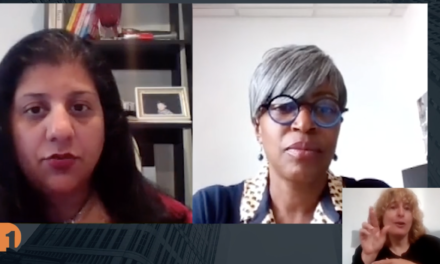What does it take to create beautiful flower arrangements year-round in Michigan? “Life in Bloom” host, and author of “Fun With Flowers” and “Bloom 365,” J Schwanke invites WRCJ radio host and producer Cecelia Sharpe into his Grand Rapids home for a lesson on flower arranging. Together, they create a two-sided flower arrangement and talk about how viewers can build their own at home.
Schwanke talks about some common obstacles, like bacteria, to consider when creating a flower arrangement, the variety of household items that can be used when arranging, and where viewers can find more resources. Plus, Sharpe learns about some of the flowers used in their arrangement and how Michiganders can create arrangements through all four seasons.
“Life in Bloom” is a PBS series, now in its fourth season, that shows viewers how to bring the beauty of flowers into their surroundings and demonstrates how living a life surrounded by colorful blossoms can reduce stress, instill wellness, and enhance happiness. Watch “Life in Bloom” with J Schwanke on Detroit Public Television’s WTVS Create channel on Sundays at 11 a.m. and Tuesdays at 6 a.m. ET.
Full Transcript:
Cecelia Sharpe, Producer/Host, WRCJ 90.9 FM: I am here with the host and creator of the television show Life in Bloom, as well as the author of Fun with Flowers, J Schwanke. And he’s going to show us how to make a flower arrangement with these lovely flowers that he has right here before us. So, J, you’ve got some great stuff here.
J Schwanke, Host, “Life in Bloom”/Author, “Fun with Flowers” & “Bloom 365”: Right?
Cecelia Sharpe: Let’s make an arrangement.
J Schwanke: Awesome. So this is all out of the garden.
Cecelia Sharpe: OK.
J Schwanke: So that’s this time of year. That’s what’s going on. So we’ve got. And typically, when you might make an arrangement, you could make it loose inside here with just water inside. You could use flower foam that you’ve soaked and put inside here.
J Schwanke: Today, we’re going to work with chicken wire. So what we would do is we take a piece of chicken wire. We kind of form fit it and we drop it down in the lip of this vase. Then that provides a structure inside there that will hold our flowers in place.
J Schwanke: We’re going to start with that with the greens that we have. And so greens always are the first thing that I do in an arrangement because I want that greenery to help form a structure. And what we’re going to do is we’re going to make what some people call a two-sided arrangement.
J Schwanke: So it’s going to be taller on two sides, and it’s going to be lower in the middle. All right.
Cecelia Sharpe: All right. A two-sided arrangement.
J Schwanke: A two-sided arrangement. Now, the other thing I love to do is I love to forage in the yard. This is actually a spirea bush that doesn’t have any blooms left on it. So but these are what’s left afterward.
Cecelia Sharpe: It’s a pretty fuchsia color.
J Schwanke: It’s still fun to be able to use something like that. Right? And so we will use that. I’m removing all the leaves that would fall below the waterline when I stick it down inside there.
Cecelia Sharpe: Why do you do that?
J Schwanke: The number one enemy to flowers is bacteria.
Cecelia Sharpe: OK.
J Schwanke: So if we have leaves that fall below the waterline, they’re going to degrade very quickly. And so that will cause bacteria in the water, which is going to shorten the vase life of our flowers. If we remove it, then we get clean stems going down inside our water. And so it will remain cleaner longer.
Cecelia Sharpe: So I have a question for you.
J Schwanke: Yes, ma’am.
Cecelia Sharpe: How can people learn how to make arrangements aside from, of course, watching “Life in Bloom?”
J Schwanke: I have a YouTube channel, J Schwanke’s YouTube channel. It’s a great opportunity because there’s hundreds of videos there that literally teach you and I have a whole series of From the Garden. So you can learn about the different types of flowers you have in the garden.
J Schwanke: We do some specifically with zinnias, some with dahlias, somewhat different types of flowers so that you can learn how to use those. And I think that that’s really important for people because YouTube is great because it gives you short little snippets and you can save it and you can work with it later. So that’s good, too.
Cecelia Sharpe: Is that a hosta?
J Schwanke: It is a hosta leaf.
Cecelia Sharpe: OK.
J Schwanke: Okay. So one of my favorites from the Garden, because it gives us a really big grounding point for our arrangement right here. And having that guy up there, it’s going to give us a visual spot for the eye to rest.
Cecelia Sharpe: OK. I smell something. It smells really good.
J Schwanke: Does it smell like pineapples? This is pineapple sage.
Cecelia Sharpe: Oh, that smells great.
J Schwanke: Right? So I love pineapple sage. It’s variegated. Has those beautiful little blooms on it. So now we’re going to use some of our zinnias and our and these beautiful little black-eyed Susans, one of my favorites because it makes us happy. Right?
Cecelia Sharpe: I love the colors.
J Schwanke: Those flowers make us happy.
Cecelia Sharpe: The orange and the fuchsia oh, the green one is beautiful.
J Schwanke: Isn’t it true? Right?
Cecelia Sharpe: Oh, wow. Oh, thanks.
J Schwanke: I mean, isn’t it pretty? Green is one of my favorites because they are so, they’re unexpected. I think people are like…
Cecelia Sharpe: Yeah.
J Schwanke: Where did that flower come from? Is that a green flower?
Cecelia Sharpe: Right, right.
J Schwanke: How in the world did we come up with a green flower?
Cecelia Sharpe: We’ve got to get this one in here.
J Schwanke: I love it. We’re going to use two of these other softer greens first.
Cecelia Sharpe: OK.
J Schwanke: And remember, we’re following this two-sided arrangement. So we’ve got it up here and then it’s going to get lower and tighter in here. There are so many people who will teach you how to do flower arranging. And I think that that’s an important concept about it. But I also think that you should find something that you really love, a method that you love with the flowers, and start to create that direction. Because when you do that, you’re going to continue to have a good feeling about what you’re doing and you’re going to like what you’ve done.
J Schwanke: And so the other thing I always encourage people to is if you don’t like where something goes, you can move it.
Cecelia Sharpe: You make us feel so good, J, about arranging flowers and believing in ourselves. You can have fun with it and make it what you want.
J Schwanke: It’s the power of flowers. You’re so right.
Cecelia Sharpe: What did you call that one again?
J Schwanke: Black-eyed Susan.
Cecelia Sharpe: Black-eye Susan.
J Schwanke: So it’s part of the Asteraceae family, which has about 150 different things in it. Including zinnias, sunflowers, daisies, Shasta daisies. All of those are in that family.
J Schwanke: OK. So now I’ve saved a couple of special things for last.
Cecelia Sharpe: OK. Like what?
J Schwanke: So we have a piece of phlox.
Cecelia Sharpe: OK.
J Schwanke: That looks like that. And that piece of phlox, I love these because they smell really good if you want to smell.
Cecelia Sharpe: Sure. Oh, yeah. It’s really fragrant.
J Schwanke: It is phlox, a late summer bloomer.
Cecelia Sharpe: OK.
J Schwanke: OK. We’re going to put him in last probably.
Cecelia Sharpe: OK.
J Schwanke: Then we have a spider. An assimilated dahlia. OK.
Cecelia Sharpe: Assimilated.
J Schwanke: Assimilated, which means that as these petals come out, they’re going to look like they were shredded on the end. So they’re like lace, right? And that’s going to be our focal flower. We’re going to put it right down here in the center of our bouquet like, nice and low.
J Schwanke: And then we’ve got this other little guy. And this is a collarette type of dahlia, which is also it looks like a daisy. So the interesting thing about dahlias is there’s thousands of species of dahlias.
Cecelia Sharpe: J, you make this look so easy.
J Schwanke: I think that’s very interesting because people say that to me a lot, and I think it’s simply practice. I think I’ve made maybe thousands, if not millions of flower arrangements because I make a flower arrangement every single day.
Cecelia Sharpe: Every day.
J Schwanke: And that’s just a way of practicing. So everyone can make it look this easy. You’re going to find things that work. You’re going to find things that don’t work. And so our listeners and our viewers can do that, too.
J Schwanke: If you take the time to enjoy the process and feel the release of this, those endorphins because people say to me all the time, I felt so good while I was making the arrangement. Exactly. That’s the power of the flowers. That’s what they do. That’s how they help us create a flower lifestyle.
Cecelia Sharpe: J, thank you so much for inviting me into your home.
J Schwanke: Thank you for coming.
Cecelia Sharpe: Absolutely. And for showing us how to make a wonderful flower arrangement, this two-sided flower arrangement, and talking about the benefits of flowers and how we can keep those flowers going every day, every season here in Michigan. Thank you so, so much.
Stay Connected:
Subscribe to One Detroit’s YouTube Channel & Don’t miss One Detroit Mondays and Thursdays at 7:30 p.m. on Detroit Public TV, WTVS-Channel 56.
Catch the daily conversations on our website, Facebook, Twitter @DPTVOneDetroit, and Instagram @One.Detroit
View Past Episodes >
Watch One Detroit every Monday and Thursday at 7:30 p.m. ET on Detroit Public TV on Detroit Public TV, WTVS-Channel 56.




